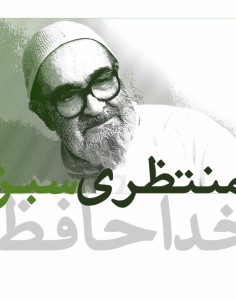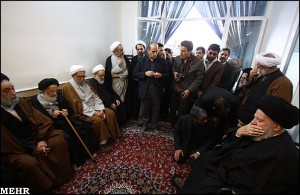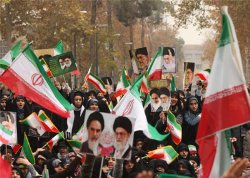Iran Special Analysis: After Montazeri --- From Protest to Victory?
 Tuesday, December 22, 2009 at 9:12
Tuesday, December 22, 2009 at 9:12  For an observer 1000s of miles away, the movement of events was dream-like. Initially, as Grand Ayatollah Montazeri's body was moved from his house to the Imam Hassan Mosque, the report were "30,000 to 40,000" on the streets. An hour later, as the procession moved from the mosque to the Massoumeh Shrine, where Montazeri would be buried, the news came of "more than 100,000".
For an observer 1000s of miles away, the movement of events was dream-like. Initially, as Grand Ayatollah Montazeri's body was moved from his house to the Imam Hassan Mosque, the report were "30,000 to 40,000" on the streets. An hour later, as the procession moved from the mosque to the Massoumeh Shrine, where Montazeri would be buried, the news came of "more than 100,000".Then it was hundreds of thousands. Not just claims of hundreds of thousands but the first pictures, with an aerial shot of of Qom filled with mourners and demonstrators. Then the videos, first in a trickle, soon a torrent, from Montazeri's house, from the mosque, from the shrine, throughout the city, in Najafabad (Montazeri's birthplace), and in other cities.
Just put two images side-by-side. Three days before Montazeri's burial, the regime struggled (and possibly manipulated) to fill Tehran's Enghelab Square with supporters. Yesterday, there was no need for PhotoShop: this was the genuine expression of emotions from anguish to anger to hope, in numbers not seen since the first days after the Presidential election.
For me, there was one key sign that this was beyond even the moments of the mid-July Rafsanjani Friday Prayer, the "40th Day memorial" of 30 July, the Qods Days demonstration of September, the 16 Azar protests two weeks ago. At no point, even as "Western" media were going Page 1 with their discovery that Iranian post-election resistance had not died, could I step back to evaluate the political significance. This was too big for snap judgements of the type that I could venture a few hours into the protests of previous occasions.
For this was a combination not only of a movement of the past six months but of political and religious sentiments of decades. Montazeri --- the pariah of 1989, dismissed as the next Supreme Leader and shunned by Ayatollah Khomeini, placed under house arrest, condemned as an irrelevancy by the regime --- was now Iran's hope.
Perhaps the most eye-catching testimony to that came not from an admirer of Montazeri or a member of the Green Wave but from a critic and defender of the current regime. Tehran Unversity academic Seyed Mohammad Marandi --insisted Montazeri "said the same thing" for 25 years, Montazeri was an insignificance, Montazeri was linked to "terrorism". What was meant to be a dismissal turned into a tribute: Marandi's words just did not match up to the videos that were reaching our desk at the same moment.
How much of yesterday's sentiment was sympathy, affection, and admiration of an important but singular figure, and how much was a well-spring of wider beliefs about the current state of an Islamic Republic, two decades after Montazeri's ostracism? And does this mean that the movement for fundamental change in the Iranian system, a movement put aside by many observers only weeks ago (note the lack of attention outside Iran to the significance of demonstrations of 4 November), is now unstoppable?
I'm not sure this morning. I'm not sure primarily because, even acknowledging that the mass sentiment yesterday was not only for Montazeri but for Montazeri as a symbol of what could and should be in Iran, a ground-swell still needs focus, direction, objectives.
The practical demands of politics are messy and long-term, compared to the sudden, clear expression we saw yesterday. So, even in the run-up to the ceremonies of Ashura on Sunday --- now how large the demonstrations? --- in the background will be all the legal, political, and religious calculations and manoeuvres that have both preoccupied and frustrated since June. Mir Hossein Mousavi and Mehdi Karroubi made their appearances yesterday, but the reconcilation now has to be not only with a crowd of mourning but of a movement that seeks a significant victory for its demands of recognition and justice.
So, no easy answers. However, I will venture one far-from-tangential conclusion. Mahmoud Ahmadinejad, six months after his claims of victory over the "dust" of opposition, is now a President of the past. I am not sure he was even prominent enough yesterday to get a specific chant from the demonstrators, but he was swept away in the cry, "Montazeri is not dead; the coup Government is dead."
It is surreal but essential ---the relevance of the irrelevant, so to speak --- to watch the interview of Ahmadinejad broadcast by America's ABC News last night. Because the encounter took place last week, both the President and the interviewer, trading punches over the nuclear issues and the detained US hikers, are unconcerned with Grand Ayatollah Montazeri and (in the interviewer's case) the political state of the opposition. So the interview now becomes testimony to a discussion taking place outside the realities of the conflict, both over the last six months and as they have evolved over the last 48 hours.
Ironically, however, Ahmadinejad's marginal position is important. Combined with the "marginal" on the other side --- the failure of Mousavi and Karroubi to get any concessions from the regime on their core demands, being met instead by more threats, the failure of others to establish a National Unity Plan --- it has led to the sharpening of the conflict between the Supreme Leader and a "radicalised" opposition. That, in turn, has led to a muddling, rather than clarifying, of the issues at hand: "radicalised" is at that point laid on certain symbolic acts such as "Death to the Dictator" chants and the omission of the Islamic Republic's coat of arms on the Iranian flag.
It is from that muddle that the next steps and possibilities will emerge. Is Ayatollah Khameini really willing to take this to a battle to the death with the Green movement or will he offer any way back from his threat to arrest them all? Does any space remain for those "within the Establishment" --- a Rafsanjani, a Larijani, other high-profile members of Parliament and Ministers --- to craft a settlement? Does the mantle of Montazeri lead Mousavi, Karroubi, or other opposition figures back to prominence not just through periodic statements but through a sustained public presence, accompanied by clear demands for changes in the Islamic Republic? Is there any possibility of a "movement from below" that frames and presses those demands to a satisfactory conclusion?
After emotions has to come political calculation. But right now, I don't have an answer to those sums and equations. I'm not sure anyone else --- Khameini, Mousavi, Karroubi, or anyone in that crowd at Qom --- does either.

 2200 GMT: Stopping the Mourners. Rouydad News carries a story we've been hearing on the Internet all evening: Iranian security forces
2200 GMT: Stopping the Mourners. Rouydad News carries a story we've been hearing on the Internet all evening: Iranian security forces 
 1735 GMT: Making Stuff Up - The Twitter Attack. There's not much to add to
1735 GMT: Making Stuff Up - The Twitter Attack. There's not much to add to  If a demonstration occurs in the square but no one really notices, does it make a sound?
If a demonstration occurs in the square but no one really notices, does it make a sound? 2310 GMT: A Sad End, Another Day. We took the night off to catch our breath (and catch up with some friends), as Iran winds down after an anti-climactic and possibly damaging day for the regime.
2310 GMT: A Sad End, Another Day. We took the night off to catch our breath (and catch up with some friends), as Iran winds down after an anti-climactic and possibly damaging day for the regime.